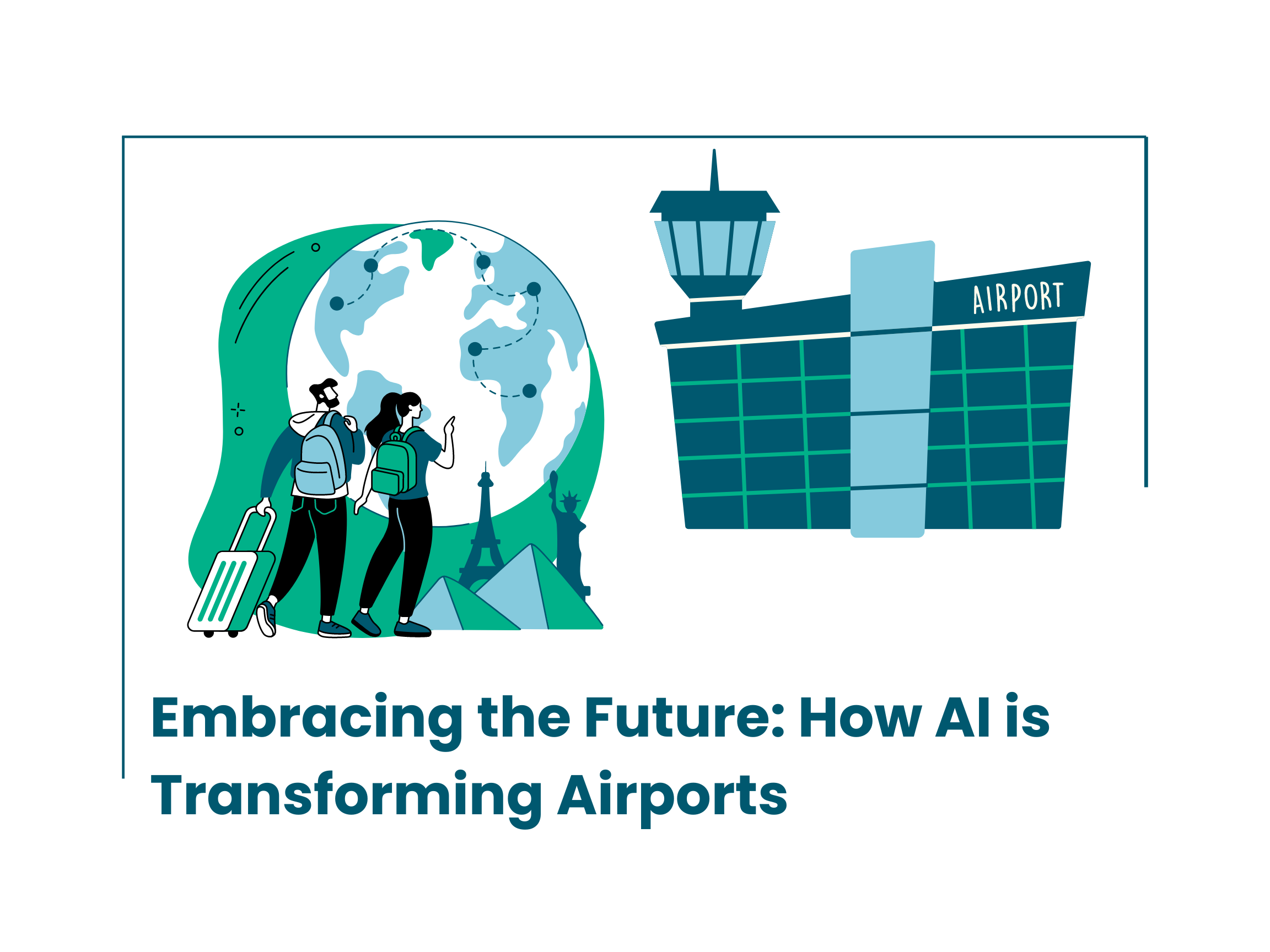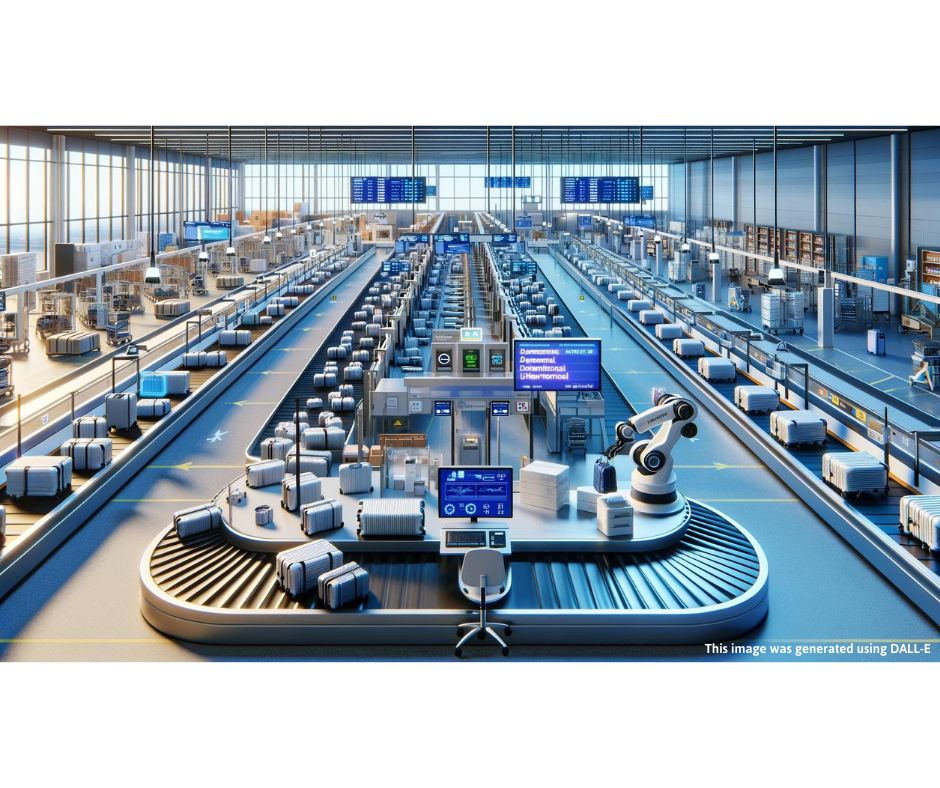Embracing the Future: How AI is Transforming Airports

Contents

ChatGPT’s introduction opened the eyes of business leaders everywhere to the potential efficiencies and innovations that AI can bring to their organizations. The airport industry is not immune to these benefits but in fact, has major opportunity in the AI world.
As we navigate through the dawn of a transformative era, the integration of AI into airport operations stands as a beacon of progress and innovation. For those at the helm of airport management and development, embracing AI is not just an option but a necessity to stay ahead. This guide aims to illuminate the path for integrating AI into airports, highlighting the opportunities that await.
The first step in leveraging AI is understanding its vast potential. AI's ability to process and analyze data at unprecedented speeds enables airports to enhance operational efficiency, improve security measures, and elevate the passenger experience. Imagine an airport where every process, from check-in to baggage handling, is optimized for speed and accuracy, thanks to AI's predictive analytics.

Streamlining Airport Operations
Operational efficiency constitutes the backbone of any successful airport. AI can transform this area by optimizing everything from flight scheduling to ground operations. For instance, AI algorithms can analyze historical data and real-time inputs to predict and mitigate potential delays. Furthermore, AI-driven robotics can be employed for tasks such as cleaning and baggage handling, freeing human staff to focus on areas requiring personal touch.
Adopting AI in operations requires a strategic approach. Start by identifying the most critical pain points in your airport's operations and assess how AI solutions can address these issues. Collaboration with AI technology providers for pilot projects can offer insights and pave the way for broader implementation.
Bolstering Security with AI: Security remains a paramount concern for airports.AI can revolutionize security measures by enhancing surveillance capabilities and streamlining passenger screenings. Real-time analysis of video feeds with systems like Scylla can detect unusual behaviors or unattended items, alerting security staff instantly. Additionally, biometric screening facilitated by AI tech like NEC’s Access Control System can expedite the verification process without compromising security.
To integrate AI into security, consider partnerships with companies specializing in AI-driven security solutions. Training for security personnel on leveraging AI tools effectively is also crucial, ensuring that technology complements human expertise.
Enhancing the Passenger Experience: In the age of AI, a personalized and seamless passenger experience is within reach. AI-powered chatbots can provide 24/7 assistance by answering queries and offering real-time updates on flights and services. Airports use software like SITA’s airport management solutions to send notifications or alerts to smartphones for convenient communication. AI can also tailor recommendations for dining and shopping, based on passenger preferences and past behavior. With Cisco Spaces, facilities can leverage location analytics and IoT data for insights on passenger flows and behavior, enabling contextual notifications and turn-by turn navigation within the airport.
Integrating AI to improve the passenger experience starts with understanding your passengers' needs and preferences. Implement AI solutions that offer value and convenience, such as mobile apps integrating AI for personalized airport guides.
Embracing Predictive Maintenance: The maintenance of airport infrastructure presents a constant challenge. AI's predictive analytics can forecast equipment failures before they occur, allowing for timely maintenance and avoiding operational disruptions. This proactive approach not only ensures the smooth running of airport operations but also extends the lifespan of assets.
Begin by equipping critical infrastructure with IoT sensors to collect data. Then, use AI algorithms to analyze this data for patterns indicating potential failures. This strategy not only reduces maintenance costs but also improves operational reliability.

Building Partnerships for Success
No airport can undertake the AI transformation journey alone. Building strong partnerships with technology providers, regulatory agencies, and other airports will be crucial. These partnerships can facilitate knowledge exchange, streamline regulatory compliance, and drive innovation. Consider joining industry consortia focused on AI in aviation to share best practices and learn from peers.
The Future is Now; Crafting a Strategic Roadmap
As we embark on the journey of integrating AI into airport operations, crafting a strategic roadmap is essential. This roadmap should prioritize areas with the highest impact on efficiency, security, and passenger satisfaction. Begin with pilot projects to test and refine AI solutions before rolling them out at scale. Engage with stakeholders—airport staff, passengers, regulatory bodies—to ensure that the integration of AI is smooth and beneficial for all parties involved.
Moreover, continuous learning and adaptation are key. The AI landscape is evolving rapidly, and staying abreast of technological advancements will enable airports to leverage new opportunities as they arise. Invest in training for staff to ensure they have the skills necessary to work alongside AI technologies effectively.
Looking Ahead At The AI-Driven Airport: The future of airports lies in harnessing the power of AI to create environments that are not just transit points but destinations in themselves. AI-driven airports will offer unprecedented levels of efficiency, security, and personalization, making air travel a more pleasant and seamless experience.
Airports are already starting to reimagine airside operations, embracing the digital era with concepts like the Intelligent Apron. The American Association of Airport Executives’ (AAAE) released a white paper summarizing a digitization project sponsored by DFW airport. The pilot was designed to explore the impact of integrated systems and new technology throughout the apron. A proactive connected gate trial was implemented, utilizing technology like Advanced Visual Docking Guidance Systems from ADB SAFEGATE, Video AI, an Apron Manager, and Pre-Conditioned Air (PC). The case study confirms that existing tools and AI technologies are available to solve common airside operational problems.
In this future, AI will be a ubiquitous presence, guiding everything from operational decisions to the way passengers interact with the airport environment. The possibilities are limitless—from autonomous vehicles ferrying passengers between terminals to AI-powered personal travel assistants providing customized advice and assistance.

The integration of AI into airports is more than a technological upgrade; it's a transformation of how airports operate and serve their passengers. Understanding AI's potential, crafting a strategic roadmap, and forging partnerships enable airport leaders to navigate challenges and unlock the opportunities presented by AI.
As we stand on the brink of this new era, the question for airports is not if they should embrace AI, but how quickly and effectively they can do so. The journey towards AI-powered airports is complex, but with careful planning, collaboration, and a commitment to innovation, the future of air travel is bright and within reach. Embrace AI, and soar into a future where airports are smarter, safer, and more enjoyable for everyone.


